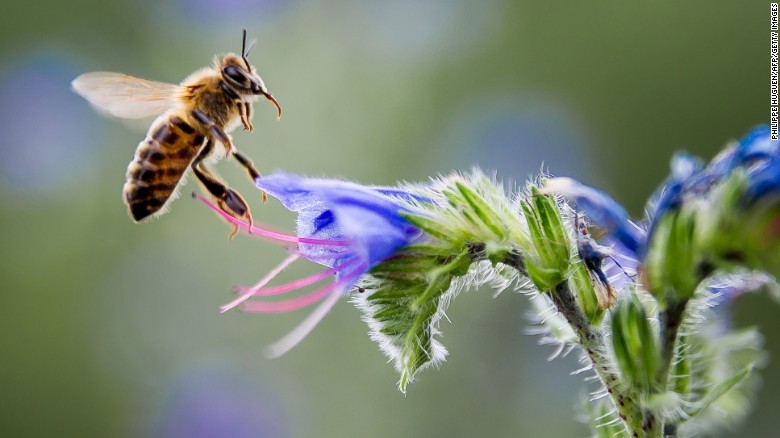The importance of honey bees and why you should be concerned that they’re disappearing
By Digna Cassens
September is National Honey Month, and pollination is vital to your diet. Bees pollinate more than 100 agricultural crops in the United States. Without bees to pollinate many of our favorite fruits and vegetables, the United States could lose $15 billion worth of crops – not to mention what it would do to your diet. Researchers call the mass disappearance of bees Colony Collapse Disorder, and they estimate that nearly one-third of all honeybee colonies in the U.S. have vanished.
United States could lose $15 billion worth of crops – not to mention what it would do to your diet. Researchers call the mass disappearance of bees Colony Collapse Disorder, and they estimate that nearly one-third of all honeybee colonies in the U.S. have vanished.

Digna Cassens
Each day, well-intentioned, albeit ignorant gardeners use insecticides and pesticides and unwittingly kill bees. Pesticides, the most deadly of which are the neonicotinoids (neonics), are deadly to our ecosystem, to our food sources and to us. These chemicals not only kill bees, but also butterflies, bats, hummingbirds, moths, lizards and very small mammals.
Would you like to live in an insect free environment? I sure wouldn’t! We live in Flamingo Heights, California, and live in an insecticide and pesticide free home — our 13 acres are never sprayed. Of course we have pests, they’re unavoidable, but with care and effort we’ve managed to let nature take care of its own balance. It’s taken three years, but we’ve reached our goal.
We have a large number of birds of all species devouring not only the seeds and nectar I put out for them, but also this summer I noticed a significant reduction in most insects.

What we do have more of are bees! In the early morning, as soon as the sun shines on the bushes and flowers, they’re covered with bees. We also have plenty of lizards and desert iguanas living in our bushes that feed on flies and other insects on our outside walls during the day — I get to watch them through my office window and when we sit outside in the vegetable garden area. If we get too many flies I set stinky pots around the property or use a farm flycatcher with an egg and milk in a small bowl attached to the bottom. To keep flying insects and moths in check at night we use yellow lights and have 2 bug zappers hanging on either side of the house. The bonus is that the turtles in the pond get bugs falling right over them, and the birds have a feast every morning — they do our cleaning for us.
Naled, a deadly poison developed in 1959 and never tested since, was sprayed from airplanes in a fine mist a few years ago in attempts to kill the Zika mosquito, decimating millions of bees. That’s millions of pollinators stopped from doing their jobs, and honeybees deprived of making their honey. Daily, other pesticides are used in smaller amounts — including Clothianidin, Carbaryl, as well as neonicotinoids, or neonics. All will poison honeybees, bumblebees and monarch butterflies as well as all the pollinating species. These chemicals also effect animals that eat these bugs, including lizards, small rodents, and some birds.
It’s important to know that although some insecticides kill the bees instantly on contact, others have slow effects that may last for up to three days before the bee dies. Neonics are slow acting. The treated seeds sprout into crops that when eaten by the insects act by slowing down their nervous system, shutting it down, causing the bees to lose their ability to learn and communicate. We all agree that controlling many insects is important, especially when those insects cause devastating harm, such as the Zika virus. However, while attempting to control the short-term danger, we cannot afford to create long-term even more damaging danger.
If we don’t act now to save the bees it might be too late. And no bees will mean an end to your favorite fruits and vegetables. Can you imagine life without almonds, apples, apricots, avocados, blueberries, cherries, cranberries, figs, grapes, olives, peaches, pears, plums, raspberries, strawberries, broccoli, carrots, cauliflower, celery, cucumbers, onions, pumpkins, melons, peanuts, soybeans, and sunflowers?
I love honey for many reasons. Honey is a very versatile ingredient that can be used by itself as a sweetener, or incorporated with other ingredients for cooking and baking. It adds moisture and flavor to foods. Although honey doesn’t contribute significant nutrients, white sugar or any processed syrups and sweeteners can’t top its flavor. Using honey in baking results in a very moist bread, cookie or cake.
Fresh honey has a clear amber color, the shade depending on the pollen source and time the honey has been kept in storage.
 I do not buy processed commercial honey, only local honey sold in jars from local beekeepers. Local honey from local honeybees means no extenders to lower the cost, and no other additives. I eat a teaspoon of honey in the morning to help with my allergies.
I do not buy processed commercial honey, only local honey sold in jars from local beekeepers. Local honey from local honeybees means no extenders to lower the cost, and no other additives. I eat a teaspoon of honey in the morning to help with my allergies.
Love honey? Help protect the bees, don’t use harmful insecticides and plant flowers that will attract beautiful bees.
More from Digna Cassens …
My philosophy is that locally sourced food is healthiest — all my recipes are my very own creations. My free time is for tending to my trees, gardens, improving the ecosystems in the area, (a small pond with rescued water turtles and frogs), and helping to preserve the High Desert by picking up trash during off-road trips. Visit my website Flavorful Fortified Food to learn more.
__________________
Our Food, Nutrition, and Your Health columnist this week is Digna Cassens, a registered dietitian nutritionist, and an expert in home-grown nutrition. She earned a BS in Foods & Nutrition at Barry University in Miami, completed a dietetic internship at Charity Hospital in New Orleans, and then earned a Master degree in Healthcare Administration from the University of La Verne, in California. She is a certified LEAP Therapist (Lifestyle, Eating, and Performance) from Oxford Labs and a Fellow of the Academy of Nutrition & Dietetics. Digna’s specialty is recipe development, food safety, sanitation, and project management and holds workshops in both English and Spanish.





















